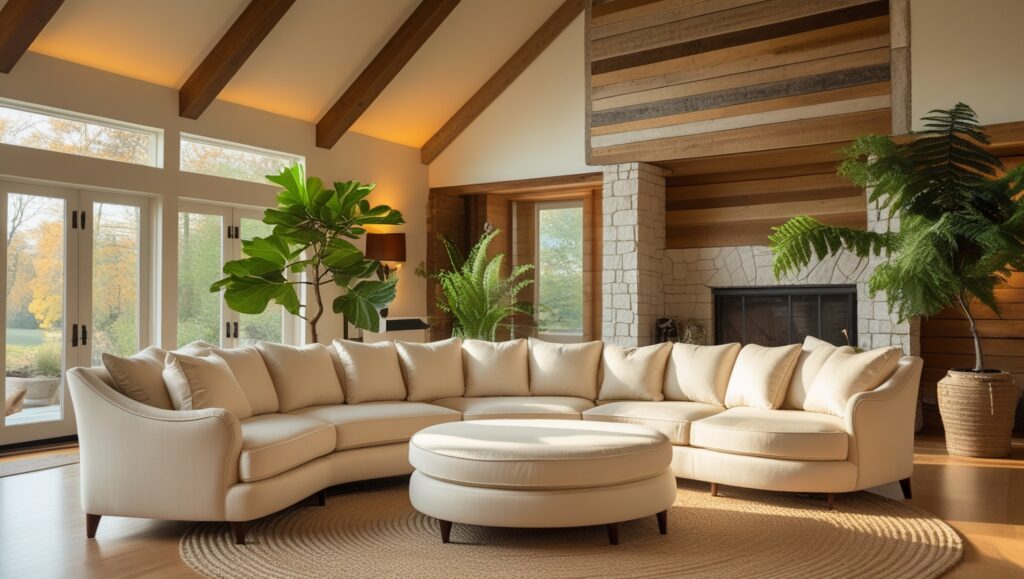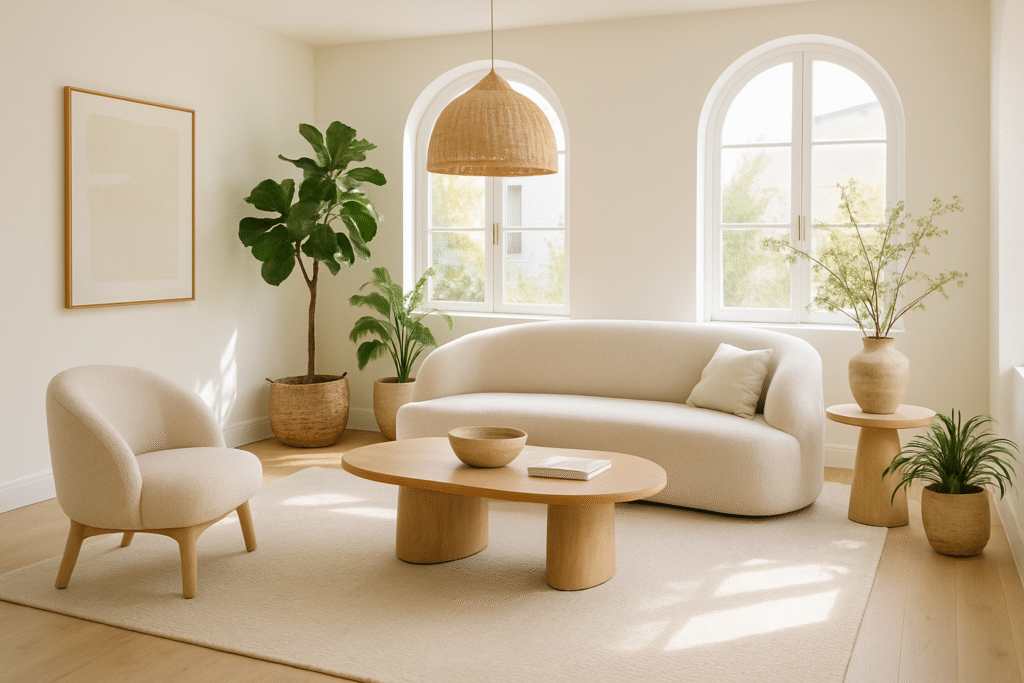Discover how the latest design innovations are transforming living spaces into sanctuaries of comfort, style, and environmental consciousness.

Why 2025’s Design Evolution Matters
The way we design our homes has never been more important. As we move deeper into 2025, our living spaces continue to evolve beyond mere aesthetics—they’ve become extensions of our values, wellbeing, and environmental consciousness. This year’s trends reflect a collective desire for spaces that not only look beautiful but also support our mental health, connect us with nature, and minimize our ecological footprint.
Whether you’re planning a complete home makeover or simply looking to refresh a corner of your garden, understanding these emerging trends will help you create spaces that feel both timely and timeless. Let’s explore the most influential home décor and garden design trends shaping 2025.
Home Decor Trends: Embracing Nature, Nostalgia, and New Forms
1. Curved, Organic Shapes: The Soft Revolution
2025 marks the definitive departure from rigid, straight-lined furniture that dominated previous decades. Curved sofas, round tables, and organically shaped chairs have taken center stage, creating spaces that feel more welcoming and visually interesting.
Why it works: Biophilic design principles tell us that humans instinctively respond positively to organic shapes that mirror what we find in nature. These softer forms create a sense of flow in rooms and encourage more intimate conversation arrangements.
How to incorporate it: Start small with rounded ottomans, curved accent chairs, or circular coffee tables. For a bold statement, invest in a curved sectional sofa that can serve as your living room’s focal point.
2. Natural Materials with Character and Patina
Raw, imperfect materials that show their age and history are increasingly valued over mass-produced perfection. Look for:
- Quarter-sawn oak furniture with visible grain patterns
- Handcrafted pottery with subtle irregularities
- Stone surfaces with natural veining and character
- Linen, wool, and cotton textiles with visible texture
- Copper and brass fixtures that develop a living patina
Why it works: These materials create authenticity and storytelling within spaces, counterbalancing our increasingly digital lives with tangible materiality that engages all senses.
How to incorporate it: Mix different natural textures in the same space—pair rough stone with smooth wood, or combine matte ceramics with glossy glass. Remember that imperfection is the goal, so embrace wood knots, stone variations, and textile slubs.
3. Fruit and Vegetable Motifs: Garden Bounty Indoors
Botanical themes have evolved beyond generic foliage to specifically celebrate fruits and vegetables in both literal and abstracted forms:
- Pear-shaped vases and lamps
- Tomato-red accent furniture
- Artichoke-inspired textiles and wallpaper patterns
- Lemon and citrus motifs on dinnerware and kitchen accessories
Why it works: This trend connects our indoor environments with the nourishment and vitality of food gardens, reinforcing our relationship with what sustains us.
How to incorporate it: Choose fruit or vegetable-themed accent pieces in colors that complement your existing palette. Kitchen textiles, throw pillows, and wall art offer low-commitment ways to embrace this playful trend.
4. Art Deco Revival and Brown Renaissance
The roaring 2020s have embraced Art Deco influences, reimagined for contemporary spaces:
- Geometric patterns and symmetrical designs
- Rich, chocolate and caramel brown tones replacing grays
- Sculptural lighting with brass accents
- Velvet upholstery in jewel tones
- Lacquered furniture with high-gloss finishes
Why it works: Art Deco references channel optimism and glamour, while brown tones create warmth and groundedness that gray simply can’t match. Together, they create spaces that feel simultaneously sophisticated and comfortable.
How to incorporate it: Add Art Deco-inspired mirrors, lighting fixtures, or decorative objects. For the brown renaissance, consider cognac leather accessories, walnut side tables, or rich terracotta textiles.
Garden Design Trends: Sustainability Meets Functionality
1. Native Plants and Nativars: The Localized Garden
The most forward-thinking gardens of 2025 center around native plant species and their cultivated variations (nativars):
- Prairie grasses replacing traditional lawns
- Indigenous flowering perennials supporting local pollinators
- Regional shade trees adapted to local climate conditions
- Native ground covers that require minimal water
Why it works: Native plants require significantly less water, fertilizer, and maintenance while supporting local ecosystems and wildlife. As climate concerns intensify, these adaptable plants prove resilient against extreme weather fluctuations.
How to incorporate it: Research plants native to your specific region and climate zone. Local botanical gardens and native plant societies can provide guidance on species that will thrive in your particular conditions.
2. Vertical Gardens and Living Walls: Growing Up
With urban living spaces continuing to shrink, vertical gardening solutions have become increasingly sophisticated:
- Modular living wall systems with integrated irrigation
- Tiered container gardens that maximize small patios
- Espaliered fruit trees against sunny walls
- Vertical vegetable gardens using stackable planters
- Trellis systems for flowering vines that create privacy screens
Why it works: Vertical gardening multiplies growing space in limited areas while creating visual interest at eye level and above. These systems can also improve air quality and provide natural cooling for buildings.
How to incorporate it: Start with a simple trellis for climbing plants or a wall-mounted container system. For more ambitious projects, consider professional modular systems with built-in watering capabilities.
3. Climate-Resilient Landscaping
As extreme weather events become more common, garden designs now prioritize resilience:
- Drought-tolerant Mediterranean plant communities
- Fire-resistant landscaping in vulnerable regions
- Rain gardens that capture and filter stormwater
- Permeable hardscaping that allows water infiltration
- Heat-tolerant plant selections for increasingly warm climates
Why it works: These approaches create gardens that can withstand environmental stresses while reducing water consumption and maintenance requirements.
How to incorporate it: Assess your region’s specific climate challenges and design accordingly. Group plants with similar water needs together (a practice called hydrozoning), and incorporate permeable pathways that allow rainwater to reach plants rather than run off into storm drains.
4. Wellness-Focused “Garden Therapy” Spaces
Gardens have transcended their decorative and productive roles to become essential for mental health:
- Sensory gardens with plants selected for fragrance, texture, and sound
- Meditation paths and contemplative seating areas
- Secluded reading nooks surrounded by greenery
- Water features with calming sounds
- Shade structures for outdoor yoga and exercise
Why it works: Research consistently confirms that time spent in garden environments reduces stress hormones, lowers blood pressure, and improves mood. Purpose-designed therapeutic gardens amplify these benefits.
How to incorporate it: Create a designated area, however small, specifically for relaxation. Include comfortable seating, plants with sensory appeal, and protection from excessive sun or wind.
5. Urban Micro-Gardening Innovations
Space-constrained urban gardeners are embracing creative solutions:
- Cloche-covered mini gardens that extend growing seasons
- Tabletop glass terrariums for indoor plant communities
- Window box food gardens with companion planting techniques
- Self-watering containers with water reservoirs
- Specialized micro-greens growing systems for kitchen countertops
Why it works: These systems make gardening accessible to apartment dwellers while providing the satisfaction of growing plants in very limited spaces.
How to incorporate it: Assess your available light conditions and select an appropriate micro-gardening method. Even a sunny windowsill can become a productive herb garden with the right containers and plant selections.
Making Smart Choices: Practical Implementation Tips
Material Selection Guidance
When selecting natural materials for home decor:
- Choose certified sustainable wood products with FSC or similar certifications
- Look for recycled metal, glass, and plastic components in furniture and accessories
- Prioritize natural fibers like organic cotton, linen, and hemp for textiles
- Consider reclaimed and vintage pieces that bring character while reducing consumption
Plant Selection Strategy
For successful garden implementations:
- Start with “workhouse” native plants that provide reliable structure
- Include at least 70% perennials for sustainability and reduced maintenance
- Select plants with staggered blooming periods for year-round interest
- Consider mature plant sizes to avoid overcrowding
- Research water and light requirements before purchasing
Budgeting Wisely
Implement these trends without breaking the bank:
- Prioritize statement pieces that have the biggest visual impact
- Update inexpensive accessories like pillows and planters to reflect new trends
- Tackle DIY projects like painting furniture in trending colors
- Shop secondhand for Art Deco-inspired pieces and natural material items
- Start with small container gardens before committing to larger landscape changes
Finding Inspiration
Develop your personal style by exploring:
- Designer showhouses (in-person or virtual tours)
- Botanical gardens with demonstration landscapes
- Local garden tours showcasing regional adaptations
- Design books focusing on biophilic and sustainable approaches
- Instagram and Pinterest accounts of garden and interior designers specializing in natural aesthetics
Bringing It All Together
The most successful homes and gardens of 2025 don’t simply follow trends—they interpret them through the lens of personal values and lifestyle needs. Whether you embrace curved furniture, native plantings, vertical gardens, or all of the above, the key is creating spaces that support your wellbeing while treading lightly on the planet.
Remember that authenticity trumps perfection. The most inviting spaces reflect their owners’ personalities and priorities while incorporating elements that feel fresh and current. As you consider how to refresh your home and garden this year, focus on changes that will bring you genuine joy and functionality.
What trends are you excited to try in your own space? Share your ideas or photos of your refreshed rooms and gardens in the comments below. We’d love to see how you’re interpreting 2025’s most inspiring design directions!

